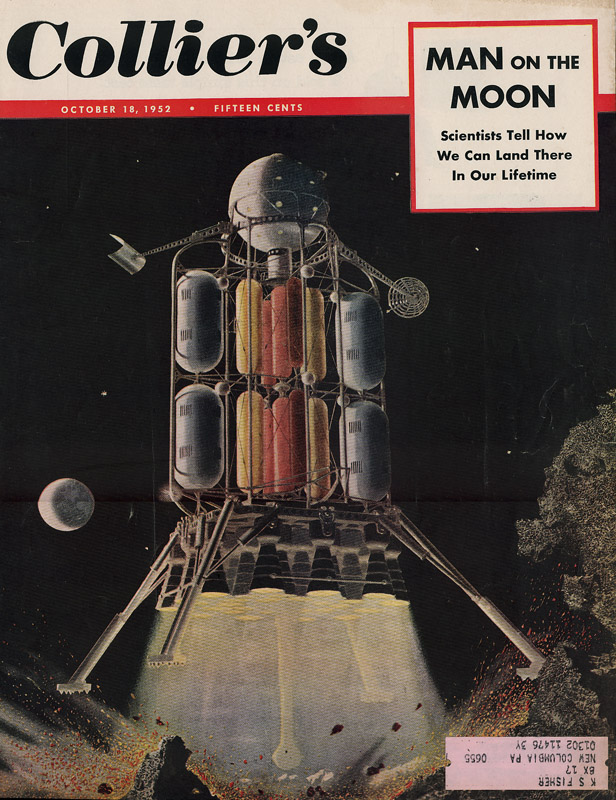LPOD Apr 25, 2008
CAN WE DO IT AGAIN?

image from Chesley Bonestell, Colliers Magazine
I just bought a copy of the Colliers magazine from October 18, 1952 which shows a massive spacecraft landing on the Moon. This is one of the famous Man on the Moon articles by Werhner von Braun that explained how humans were going to the Moon. The realistic illustrations by Chesley Bonestell and the very believable article made space travel seem inevitable to me and millions of other readers of this immensely popular weekly magazine. Do we have an equivalent powerful mode of inspiration today? Colliers, Life and most similar magazines are long gone, and TV and the Internet are so saturated with information that nothing can probably have the influence of the old weekly magazines. The Colliers issues have become classics and they still have a strong impact. How will we excite today's youth (who are failing to finish high school in record numbers and know little when they do) to undertake the hard work necessary to go back to the Moon, re-engineer society on Earth, and make the future better than the past?
Chuck Wood
Related Links
Bonestell Space Art
COMMENTS
To post comments regarding this LPOD, please click here and enter your text in the space below. You will not see the Edit tab unless you register for the wiki. Please do not edit the LPOD itself!
(1) I've heard comments from several teachers about how boys are falling behind in math and science studies--or are simply not taking the courses. An astronomy professor I know recently noted that young women are leading in his courses and in his research projects. He said that young men are badly under represented.
Another teacher noted that boys on the high-school level seemed to be focused on skateboarding, video games, and sports. She said many of them have the brains for math and science studies, but don't want to bother taking the courses.
This is anecdotal information, of course. I don't know how widespread the education problems are. If they are widespread, however, I put a lot of the blame on a popular culture being promoted by the entertainment and sports industries that disrespects and devalues education.
The message we are getting is that all of life is a beer commercial.
Apologies for getting on my soapbox...
--Bill
(2) About the depicted spaceship above (on the Colliers cover).
In one of the extraordinary "Blake and Mortimer" albums by Belgian author Edgar P. Jacobs (the album "The Riddle of Atlantis") there's a remarkable fleet of red-painted spaceships which look very much like the one in Chesley Bonestell's illustration. I guess Edgar P. Jacobs was an admirer of Chesley Bonestell's paintings and illustrations (and also of Rolf Klep's and Fred Freeman's; which were the two other illustrators of Willy Ley's and Wernher Von Braun's spaceflight articles in Colliers).
I have to search an online image of E.P. Jacobs' red-painted spaceships.
--Danny C.
(3) It is also interesting to search the curious moon- and spaceflight-related paintings made by George Solonevich (the illustrator of Otto Binder's space-books for youngsters). In many of George Solonevich's paintings, the lunar surface's mountains and craters look VERY strange, as if they were made of fluid candle-wax, shaving-soap, and masked potatoes. I wonder if George's illustrations were photographs of hand-made surfaces, instead of paintings... (the mountains look a bit "shiny").
Note that George Solonevich's spaceships and lunar landers were also derived from Chesley Bonestell's (George's were a bit more "Art Nouveau"-like!).
G.Solonevich's lunar mountains and central peaks are the typical example of how we wanted them to be ("high and steep").
It would be interesting to add one of George Solonevich's lunar paintings as an LPOD! (pure childhood nostalgia!).
P.S.:
Another illustrator of those days: John Polgreen.
--Danny C.
(4) Fighting the din of other distractions in our American culture will be a difficult challenge. Although maybe we are looking at things in the wrong direction. Going back to the Moon is really about starting our first real outreach into living somewhere other than Earth or in orbit. Its about living on another world. That's different than a race. And thus not everyone will really be interested.
The people who really need to be interested are those approving funding. Keeping their attention is the bigger challenge. It would help if the Moon offered up some form resource that we need back here on Earth. Something that we can build a dependency upon for our technology. That would keep interest very much alive. Although its still a worthy goal regardless of lunar exploitation ability.
--- Aethrae, Andrew Martin SFO